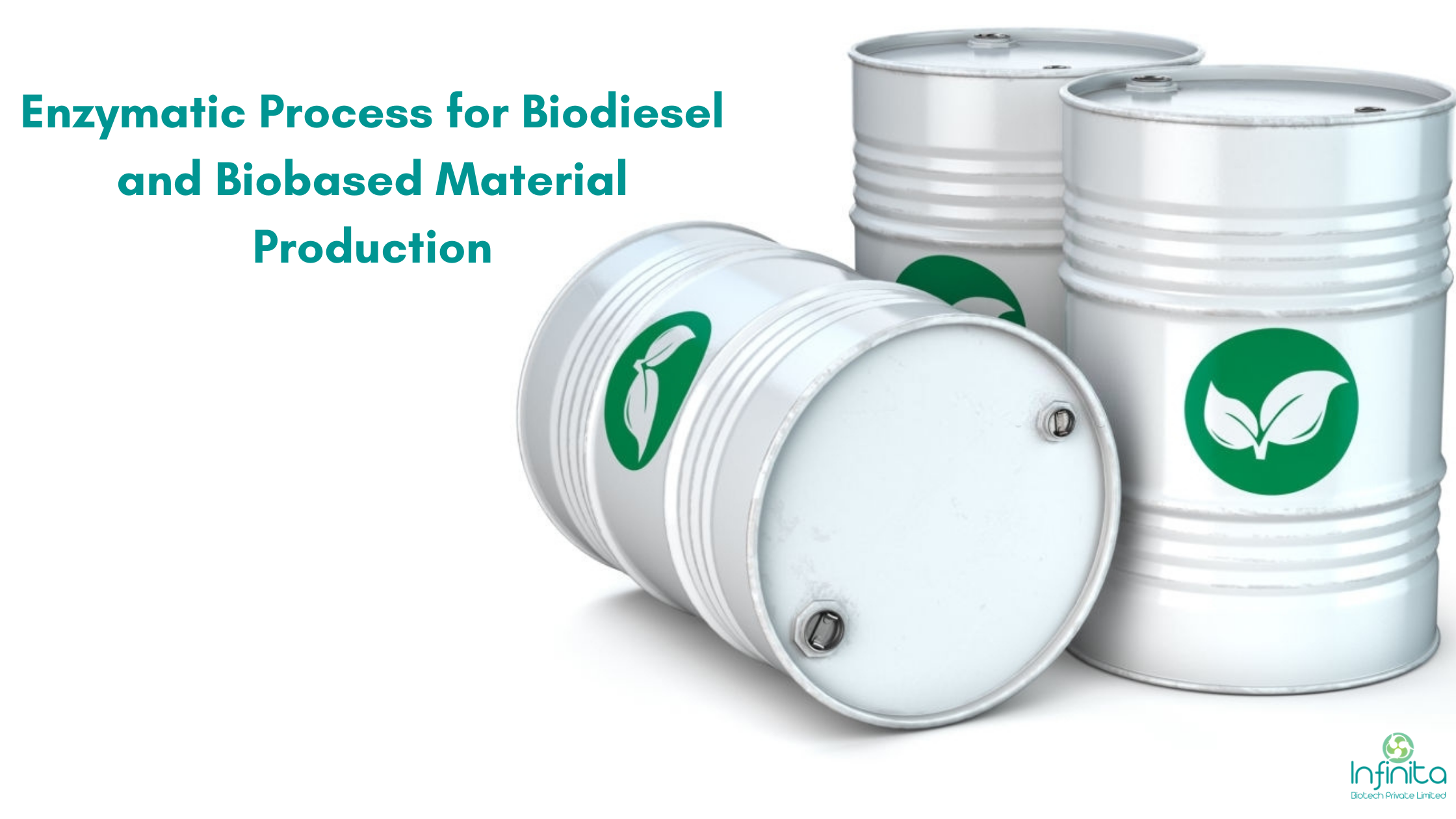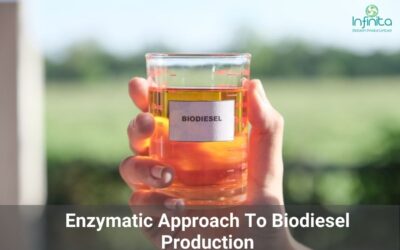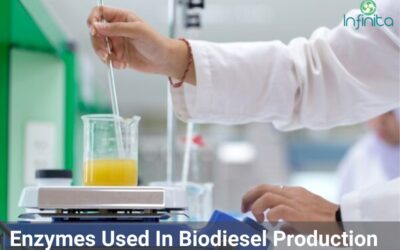
Enzymatic Process for Biodiesel and Biobased Material Production
Biodiesel is generally made from edible oils like corn oil, soya bean, sunflower, palm, and rapeseed oil and even from used oil leftover from fast food and restaurant chains. But research is taking place in replacing edible oils with non-edible ones due to the looming food shortage the world may face in the future.
Biodiesel plants for production use the conventional transesterification process involving alcohols and oils. Though this process is generally followed yet it suffers from some serious drawbacks like costly production process and environmentally adverse effects like high amounts of wastewater produced, chemical disposal, and low-grade glycerol co-product. Since this is an alkaline process like most other chemical approaches, the production comprises only a transesterification reaction.
Conversion of free fatty acids is not effective and leads to the formation of soap. The acid process for biodiesel production only uses an esterification reaction to convert free fatty acids or FFA into biodiesel. Oils used for biodiesel production contain a significant amount of FFA’s, so they can be utilized fully only by combining both alkaline and acidic processes. But this results in nearly doubling the investment and the operating cost which ultimately results in biodiesel costing much more than diesel derived from fossil fuels. This is not feasible in the long run without the governments providing subsidies to the industry.
Biodiesel has always been costly than petroleum diesel and if we examine the biodiesel plant production closely, we come to the realization that feedstock oils use anywhere between 70 to 90 percent of the costs and the rest is operating cost with miscellaneous costs of 5 percent. To be commercially relevant, the feedstock cost has to come down to 50 percent and less than the exorbitant 90 percent.
The enzymatic process is an environmentally friendly and relatively clean process for the production of biodiesel as it converts both triglycerides and FFA’s simultaneously into biodiesel. But high operating costs, expensive enzymes, low yields, a shorter catalyst lifespan, and longer reaction times have been attributed to this process. But the biggest advantage of this process is that it is environmentally friendly as there is no chemical discharge and there is no wastewater as there is no need for water washing. The enzymatic process of simultaneously converting FFA’s and triglycerides into biodiesel through transesterification and esterification is particularly useful for oil stock which has been in storage for a long time and cannot be processed immediately. Another advantage of this process is that it requires lower energy consumption as the reactions happen in mild conditions. Modifications and discoveries made in the last 30 years have made this process more efficient. Let’s look into the new efficient process below.
The Improved Enzymatic Process
The new process was developed to improve production in biodiesel plants. Here two reactors are used, a primary reactor and the second reactor called a trim reactor. Feedstock oils, an inert solvent, recycled biodiesel, and a reactant composed of alcohol are mixed thoroughly and then put in the primary reactor. The reactor can be either Continuous Stirred Tank Reactors (CSTR) or have a packed bed. The outlet of the reactor has an evaporator connected to it to evaporate water, inert solvent, and unreacted alcohol. The left residue of biodiesel, glycerol, and unreacted oil gets separated into two layers of liquid. The upper layer is raw biodiesel in its crude form and the lower layer is glycerol in its crude form having trace amounts of alcohol and solvent.
In the biodiesel plant, the inert solvent is now mixed with the crude form of biodiesel and the reactant of make-up alcohol and fed into the trim reactor where the reaction is completed. The output is sent to an evaporator also to separate biodiesel and crude glycerol into two different layers. The biodiesel thus produced is pure, without any need for distillation. Crude glycerol is again sent to an evaporator to remove alcohol, water, and residual solvent by evaporation to produce pure glycerol though in a colored form. It is decolorized using activated carbon for use as a pharmacological product.
Recycling Process
Inert solvent along with water and alcohol reactant is condensed and then collected and sent to the solvent recovery unit where inert solvent and alcohol reactant is separated, purified, and then recycled for use again. Trace water is discharged. The reaction is carried out at room temperature and the reaction time takes between ten minutes to one hour depending upon the oil used in production and the alcohol reactant.
This new improved enzymatic process is better economically than the conventional process. The lipase or enzymes can be used for longer periods of 12 to 18 months and the half-life of lipase is more than five years. Also, the amount of lipase or enzyme required for the reaction to succeed is less than 3 % per stream day. For example, a biodiesel plant with a capacity of 150 tons per day, less than 4.5 tons of lipase is required. The lipase cost and performance can be much improved with mass production over time. This will further reduce the lipase expense in the enzymatic process.
Cost Analysis
Cost analysis was done by taking crude palm oil with 8% FFA as a subject in the biodiesel process in South East Asian regions especially Malaysia and compared it with crude oil. Further studies were undertaken by taking several other oils edible or otherwise costing less than palm oil with different levels of FFA’s present like Jatropha oil with 15% FFA, Rubber seed oil and castor oil with 18% FFA, and Rice bran oil with above 40% FFA. The analysis was that biodiesel can be produced at less cost than diesel by using these oils among others as feedstock with subsidies no longer required for continued production of biodiesel
Conclusion
Due to the rising cost of fossil fuels, the economy of several regions has taken a hit. For areas with underdeveloped infrastructure where the supply of fuel is inconsistent, integrated biodiesel plants should be established in a distributed manner. Cultivation of oil seeds should be encouraged locally so the feedstock is sourced easily and directly from cultivators. This will result in both the economic growth of the region with employment provided to various primary, secondary and tertiary sectors like agriculture and industry and also lead to less cost of biodiesel. In the long run, this will lead to totally self-sufficient and economically empowered communities with an ample supply of fuel
LIPASE COMPLEX ENZYMES
Our specialised Lipase Complex Enzymes for esterification of edible and non – edible Oils can be utilised to produce biodiesel.

Eco-Friendly

Efficient
Esterification

Highly Specific
Lipase
Related Articles
Enzymatic Approach To Biodiesel Production
Enzymes In Biodiesel Production With fossil fuels getting extinct, there are alternative ways that are found by scientists and researchers to generate energy that is required to run the world. You must look for the energy sources from where the power can be produced...
Which Enzymes Are Used In Biodiesel Production?
Enzymes Used In Biodiesel Production Fluid fuels have been utilized for a long time as the most predominant and fundamental fuel for engine motors. Be that as it may, depleting fossil fuel reserves, and the propensity for developing new sustainable biofuels, have...

Enzymatic Process for Biodiesel and Biobased Material Production
Biodiesel as an alternative fuel is gaining demand all over the world due to environmental concerns and depletion of the traditional fossil fuel industry worldwide. But there were concerns like high economic cost in utilizing biodiesel process which can and has been brought down using the improved enzymatic process in biodiesel production.
Biodiesel is generally made from edible oils like corn oil, soya bean, sunflower, palm, and rapeseed oil and even from used oil leftover from fast food and restaurant chains. But research is taking place in replacing edible oils with non-edible ones due to the looming food shortage the world may face in the future.
Biodiesel plants for production use the conventional transesterification process involving alcohols and oils. Though this process is generally followed yet it suffers from some serious drawbacks like costly production process and environmentally adverse effects like high amounts of wastewater produced, chemical disposal, and low-grade glycerol co-product. Since this is an alkaline process like most other chemical approaches, the production comprises only a transesterification reaction.
Conversion of free fatty acids is not effective and leads to the formation of soap. The acid process for biodiesel production only uses an esterification reaction to convert free fatty acids or FFA into biodiesel. Oils used for biodiesel production contain a significant amount of FFA’s, so they can be utilized fully only by combining both alkaline and acidic processes. But this results in nearly doubling the investment and the operating cost which ultimately results in biodiesel costing much more than diesel derived from fossil fuels. This is not feasible in the long run without the governments providing subsidies to the industry.
Biodiesel has always been costly than petroleum diesel and if we examine the biodiesel plant production closely, we come to the realization that feedstock oils use anywhere between 70 to 90 percent of the costs and the rest is operating cost with miscellaneous costs of 5 percent. To be commercially relevant, the feedstock cost has to come down to 50 percent and less than the exorbitant 90 percent.
The enzymatic process is an environmentally friendly and relatively clean process for the production of biodiesel as it converts both triglycerides and FFA’s simultaneously into biodiesel. But high operating costs, expensive enzymes, low yields, a shorter catalyst lifespan, and longer reaction times have been attributed to this process. But the biggest advantage of this process is that it is environmentally friendly as there is no chemical discharge and there is no wastewater as there is no need for water washing. The enzymatic process of simultaneously converting FFA’s and triglycerides into biodiesel through transesterification and esterification is particularly useful for oil stock which has been in storage for a long time and cannot be processed immediately. Another advantage of this process is that it requires lower energy consumption as the reactions happen in mild conditions. Modifications and discoveries made in the last 30 years have made this process more efficient. Let’s look into the new efficient process below.
The Improved Enzymatic Process
The new process was developed to improve production in biodiesel plants. Here two reactors are used, a primary reactor and the second reactor called a trim reactor. Feedstock oils, an inert solvent, recycled biodiesel, and a reactant composed of alcohol are mixed thoroughly and then put in the primary reactor. The reactor can be either Continuous Stirred Tank Reactors (CSTR) or have a packed bed. The outlet of the reactor has an evaporator connected to it to evaporate water, inert solvent, and unreacted alcohol. The left residue of biodiesel, glycerol, and unreacted oil gets separated into two layers of liquid. The upper layer is raw biodiesel in its crude form and the lower layer is glycerol in its crude form having trace amounts of alcohol and solvent.
In the biodiesel plant, the inert solvent is now mixed with the crude form of biodiesel and the reactant of make-up alcohol and fed into the trim reactor where the reaction is completed. The output is sent to an evaporator also to separate biodiesel and crude glycerol into two different layers. The biodiesel thus produced is pure, without any need for distillation. Crude glycerol is again sent to an evaporator to remove alcohol, water, and residual solvent by evaporation to produce pure glycerol though in a colored form. It is decolorized using activated carbon for use as a pharmacological product.
Recycling Process
Inert solvent along with water and alcohol reactant is condensed and then collected and sent to the solvent recovery unit where inert solvent and alcohol reactant is separated, purified, and then recycled for use again. Trace water is discharged. The reaction is carried out at room temperature and the reaction time takes between ten minutes to one hour depending upon the oil used in production and the alcohol reactant.
This new improved enzymatic process is better economically than the conventional process. The lipase or enzymes can be used for longer periods of 12 to 18 months and the half-life of lipase is more than five years. Also, the amount of lipase or enzyme required for the reaction to succeed is less than 3 % per stream day. For example, a biodiesel plant with a capacity of 150 tons per day, less than 4.5 tons of lipase is required. The lipase cost and performance can be much improved with mass production over time. This will further reduce the lipase expense in the enzymatic process.
Cost Analysis
Cost analysis was done by taking crude palm oil with 8% FFA as a subject in the biodiesel process in South East Asian regions especially Malaysia and compared it with crude oil. Further studies were undertaken by taking several other oils edible or otherwise costing less than palm oil with different levels of FFA’s present like Jatropha oil with 15% FFA, Rubber seed oil and castor oil with 18% FFA, and Rice bran oil with above 40% FFA. The analysis was that biodiesel can be produced at less cost than diesel by using these oils among others as feedstock with subsidies no longer required for continued production of biodiesel
Conclusion
Due to the rising cost of fossil fuels, the economy of several regions has taken a hit. For areas with underdeveloped infrastructure where the supply of fuel is inconsistent, integrated biodiesel plants should be established in a distributed manner. Cultivation of oil seeds should be encouraged locally so the feedstock is sourced easily and directly from cultivators. This will result in both the economic growth of the region with employment provided to various primary, secondary and tertiary sectors like agriculture and industry and also lead to less cost of biodiesel. In the long run, this will lead to totally self-sufficient and economically empowered communities with an ample supply of fuel
0 Comments
Submit a Comment
You must be logged in to post a comment.
LIPASE COMPLEX ENZYMES
Our specialised Lipase Complex Enzymes for esterification of edible and non – edible Oils can be utilised to produce biodiesel.

Eco-Friendly

Efficient Esterification

Highly Specific Lipase
Enzymatic Approach To Biodiesel Production
Enzymes In Biodiesel Production With fossil fuels getting extinct, there are alternative ways that are found by scientists and researchers to generate energy that is required to run the world. You must look for the energy sources from where the power can be produced...
Which Enzymes Are Used In Biodiesel Production?
Enzymes Used In Biodiesel Production Fluid fuels have been utilized for a long time as the most predominant and fundamental fuel for engine motors. Be that as it may, depleting fossil fuel reserves, and the propensity for developing new sustainable biofuels, have...



0 Comments